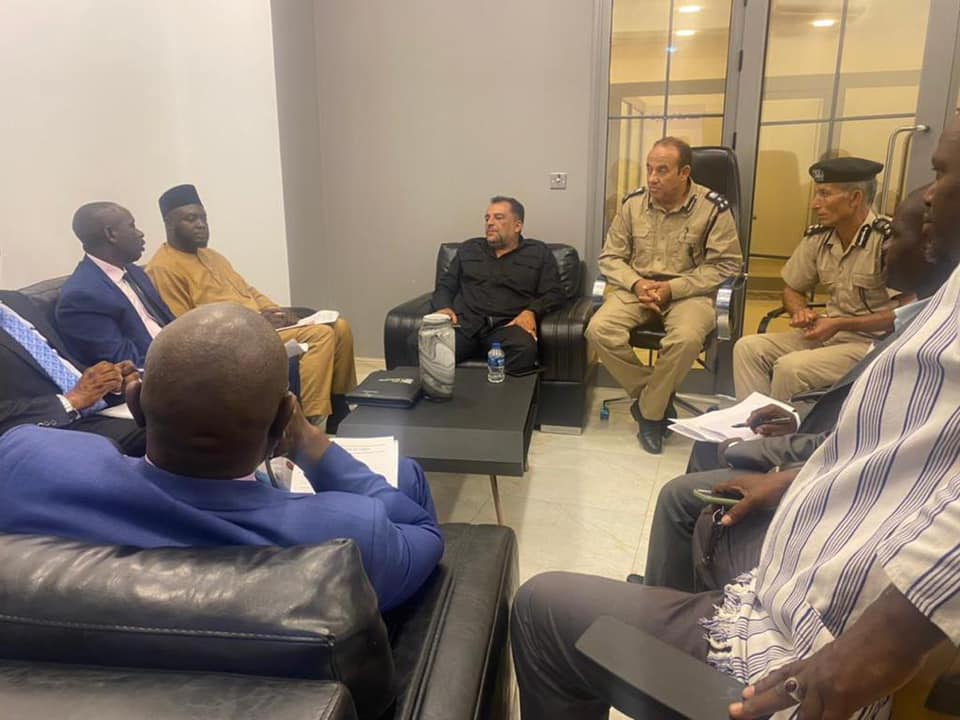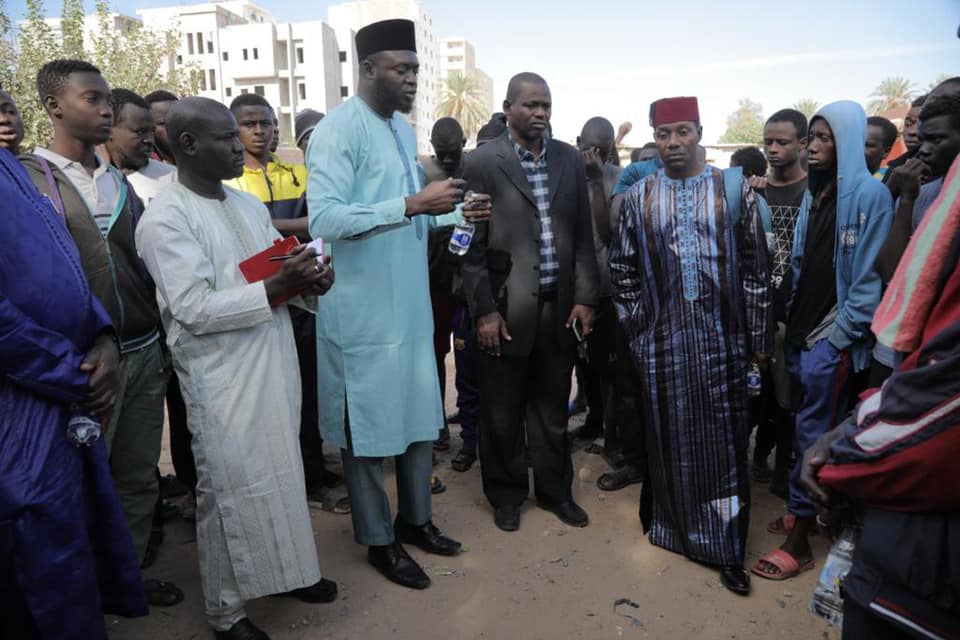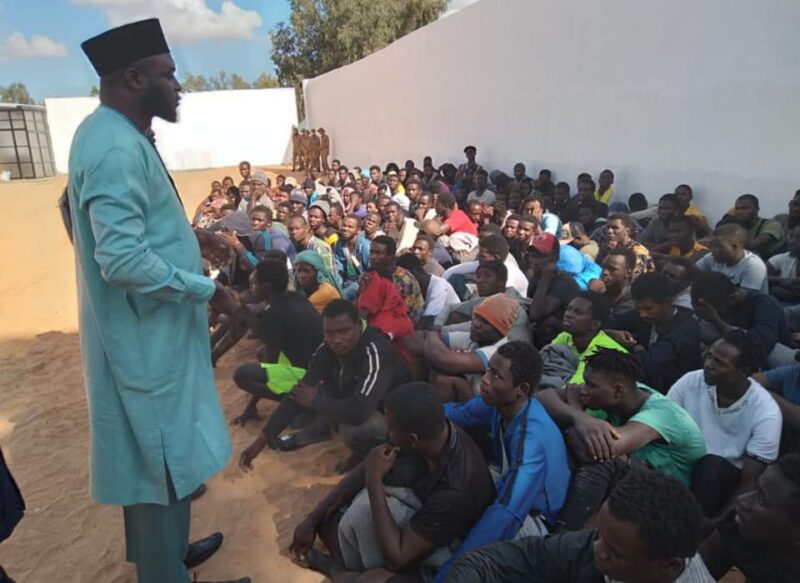The Director of Diaspora, and Migration Directorate at the Ministry of Foreign Affairs, International Cooperation and Gambians Abroad, Mr. Musa Camara recently led a delegation of relevant government authorities to Tripoli, Libya, where four hundred Gambian migrants are believed to have been detained. In this exclusive interview, in addition to explaining their mission to negotiate the release and subsequent repatriation of the detained migrants, Director Camara expounded on the functions of his directorate, his relationship with the diaspora, the role of the diaspora in national development and the rigours of return and reintegration mechanisms.

Bellow is the full Q and A between Mr Camara, and Ms. Ya Awa Touray, Information Officer at the Ministry of Foreign Affairs.
Read on:
Q1. Before we get to your trip to Libya could you tell us a bit about the Directorate of Diaspora and Migration
Many thanks for this interview. The Diaspora and Migration Directorate was established at MoFA in 2018. However, following my deployment as Director in January 2021, the Directorate has been very strategic and responsive to the needs and aspirations of The Gambian Diaspora. It has been facilitating a structured and optimal interface between the Government and the Diaspora in a bid to harnessing and maximizing their potentials for national development.
Q2 And how has the Diaspora responded to this initiative?
There has been a massive Diaspora engagement and they have been very receptive to our engagement. I am happy to say that I have a wide network amongst The Gambian associations, communities and networks across the globe over time. I salute them all for their contributions to the socio-economic development of the country.
Q2.What do you think can be done to get the Diaspora more involved in national development?
The Gambian Diaspora is a force to be reckoned with. They are very organized and they support each other through their associations, communities and networks. Their contributions and support to their families through remittances have been very profound and outstanding. However, there is need for them to consider investing in the productive sectors of the economy. This will enhance economic growth and creation of employment. Further, we have a highly skillful Diaspora in the USA, the UK and Scandinavia; just to name a few. Through short term and medium-term mentorship programs, they can help in knowledge and skills transfer in strengthening the capacities of the public, private and third sectors. Their political participation is also very key, and relevant. This will increase trust and abridge the existing gap.

Furthermore, a Diaspora Strategy has been developed as a roadmap for engaging and harnessing their potentials in national development. A Diaspora website and data portal has also been developed to share with them existing opportunities in the country and to have data of their various skill sets. Diaspora roundtable conferences are held annually including Stake of the Nation’s Forum to discuss how the Gambian Diaspora will effectively participate and contribute meaningfully to national development.
Q3. I understand your visit to Tripoli was a consular mission and a chance to engage, and negotiate with Libyan authorities for the release and subsequent repatriation of four hundred (400) Gambians currently in prisons and detention centers; how did that go?
Well, the importance of this mission cannot be overemphasized. It gave us the opportunity to meet with relevant Libyan authorities including the Ministries of Foreign Affairs, Interior, Justice; and Anti-Illegal Immigration Agency. The authorities received us very cordially and facilitated our visits to various detention centers. We met 218 migrants at a particular detention centre who were intercepted at the sea or were suspected of going to the sea. We also met 14 minors elsewhere and another 160 who were given exit visas in a bid to return voluntarily. There were about 42 Gambian nationals that were convicted and jailed due to drug cases or smuggling and trafficking in persons. However, 350 were at a particular detention centre at Washaafana, which is either not under government control or due to security reasons, could not be accessed. Notwithstanding, we are still working with the Libyan authorities through their Embassy here and The Gambian Association in Libya through a Presidential Council to have access to them.
The authorities agreed to release the 218 and 14 minors provided they agree to be repatriated to The Gambia. The IOM already chartered a non-scheduled flight that was supposed to repatriate the 160 already issued with exit visas. However, only 105 came out of the 160 on 16th November 2022. We had meetings with IOM Libya, who agreed to charter another non-scheduled flight to bring the remaining provided they are willing to return voluntarily. The Gambian Association has already taken their pictures and registered them for issuance of an emergency travel certificate.
Q4. I am sure this is your first time of visit to Tripoli, what do you think of the place ?
Tripoli is very peaceful, calm and the people are friendly. There are Gambian communities living there with their families since late 70s. The community has their own football team that is currently participating in an Inter-African Union Football competition, and is also the defending champions of the previous league.
Q5. How about the living conditions of Gambian migrants in Libya?
By and large, the members of The Gambian community settled in Libya are happily living there. They have their residential and /or work permits and freely going about their businesses.
However, nothing is easy for the migrants with irregular status we met. They look very frail, weak and sickly. Some are school dropped-outs while others have not even gone to school and have no requisite skills. One of the minors we met came from Basse Dampha Kunda. He said he was intercepted two times but any time he wants to return, his mother insists he must stay.

Q6. What is the gender proportion and average age bracket of these Gambian migrants?
Their ages range from 16 years to 35 years. At the detention centers, we did not see any female migrants but we understand in the city, there are.
Q7. What types of jobs are they engaged in?
The settled Gambians of course have regular jobs; some are working with companies. Conversely, the migrants intending to cross the ocean do menial jobs to support themselves to proceed on their journey. Some claimed they have no intention to proceed but are working to support their parents back home.
Q8. What have some of them told you about the journey?
The 218 migrants we met at a particular detention center and the 160 awaiting a flight to return all regretted embarking on the journey. They lamented that what they were told and what they found were too far apart. A good number were crying and begging us that we should not leave them at the detention center.
Q9.What diplomatic channels were used by The Gambia Government to secure the release and repatriation of these migrants?
The Libyan Embassy in The Gambia was very supportive. The Gambian Association too is very proactive but the bilateral engagement the delegation had with various relevant sectors coordinated by the Libyan Foreign Ministry really helped in making the mission very successful. I believe the Consular Mission has really facilitated the strengthening of the bilateral ties between our two countries.
Q10. Considering that this is a large number, what are some of the opportunities available for them back here if they decide to come home?
Well, IOM gives reintegration support to all returning migrants, though it has been argued that this is not sustainable. The available opportunities might also be limited depending on the skills they possess; however, one good opportunity is car washing, brick and tile laying, welding, upholstery and carpentry and petty business, these have been very lucrative nowadays.
Q11.How is the Gambia Government collaborating with partners such as IOM to facilitate the return of migrants in Libya?
The Government is working very closely with IOM. We share information and we coordinate our efforts together. IOM is willing to operate more flights to return voluntary Gambian migrants.
Q12. Upon arrival, would there be any reintegration packages these returnees?
Yes, there will be. Actually, the Assisted Voluntary Return and Reintegration (AVRR) Project that was providing reintegration support to voluntary migrant returnees has phased out. However, from January 2023 a new project will be available to continue providing reintegration support to migrants returning.
Q13. I understand there is no Gambian consular representation in Libya, is there any plan for this?
Great! The Foreign Ministry is on the process of appointing a Liaison Officer as the Country’s diplomatic representative in Libya, who will work closely with The Gambian Association to provide consular services and assistance to Gambians in Libya. This appointment will bring a big relief to the plight of the migrants.
Q14. And finally what would you say The Gambia Government achieved in this trip?
The mission was really timely and fulfilling. The Gambian Community was exceedingly happy. Other issues including documentation of Gambians born in Libya, school for Gambian children, welfare and fundamental human rights of the migrants were extensively discussed. Further, the mission enabled the Libyan authorities to also recognize The Gambian Association more today than ever before.
Upon return, I had a meeting with the Libyan Ambassador to The Gambia, and he requested for our report so that he will also make follow-up on certain action points with the relevant Libyan authorities through their Foreign Ministry.
Source: MoFA




